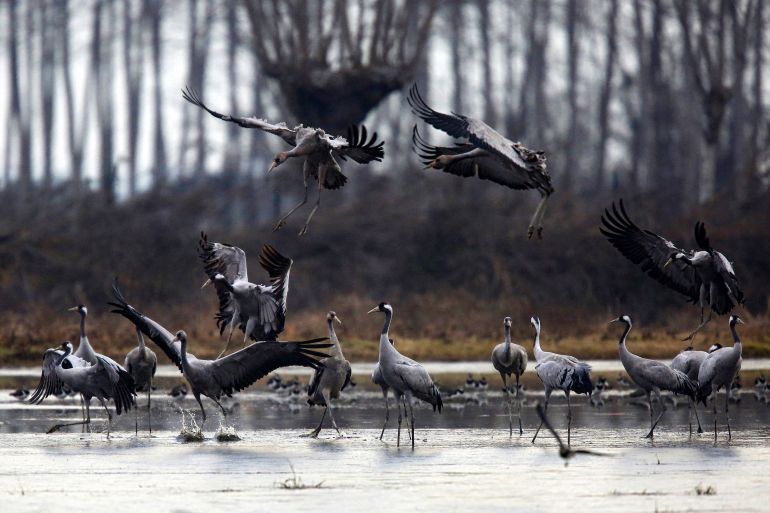Wildlife numbers are down 69% — here’s how we can fix this crisis
It’s a red alert for the planet. But we have the tools to reverse much of this loss — if we have the will.

This summer was Europe’s hottest on record, with blistering heatwaves and wildfires accelerating emissions to rise to a 15-year high. Kenya is suffering the worst drought it has seen in more than 40 years while Pakistan is grappling with devastating floods, killing thousands of people and displacing millions.
Deforestation of the Amazon rainforest in Brazil has hit a six-year high and tropical storms are battering the Caribbean. Overconsumption by wealthy nations is causing the planet’s most vulnerable people to suffer, and nature is at a crisis point.
Keep reading
list of 4 itemsMalaysia plans ‘orangutan diplomacy’ in palm oil pitch
‘First time’: Wild orangutan performs self-medication
Three Eswatini chiefdoms overcome rivalry to preserve indigenous forest
Sadly, that trend extends to the animal kingdom. Published on Thursday, WWF’s Living Planet report captures a shocking drop in monitored wildlife populations across the globe — an average 69 percent in less than a lifetime. Populations of mammals, birds, amphibians, reptiles and fish are all shrinking.
The world’s tropical regions – some of the most biodiverse places on the planet – are seeing populations of their species plummet, with an average 94 percent fall across Latin America and the Caribbean since 1970. During the same period, wildlife populations in Africa plunged by 66 percent, while the Asia Pacific saw a 55 percent drop.
Meanwhile, freshwater populations have seen an average 83 percent fall. Our rivers, lakes and wetlands – the lifeblood of all human society – are dying. The health of these freshwater ecosystems is essential for one in 10 animals, but also for all eight billion of us humans who rely on them for everything from farming and industry to the water we drink.
These shocking drops symptomatise ongoing global neglect of biodiversity. Already, it is predicted that even if we limit global warming to 1.5 degrees Celsius (2.7 degrees Fahrenheit), large parts of the Amazon and Africa could lose between half and three-quarters (PDF) of their biodiversity.
Yet, such a catastrophic prospect would affect us all, whether it is our social stability or individual wellbeing and health. It also undermines basic human rights for those disproportionately suffering the effects in the Global South.
It even affects us economically: WWF’s Global Futures study estimated that the decline of natural assets will cost the world at least $406bn a year – adding up to almost $9 trillion by 2050 – roughly equivalent to the combined economies of the United Kingdom, France, India and Brazil.
Despite governments signalling that they are prioritising nature, we are currently seeing a lack of high-level political support and leadership towards tackling the biodiversity crisis. An impressive 40,000 people, including 120 world leaders, attended the United Nations’ 26th session of the Conference of the Parties (COP 26) in Glasgow last year, with some significant pledges made. Yet in the lead-up to the 15th biodiversity meeting of the Conference of the Parties (COP 15) in December, countries like Brazil are continuing to destroy natural habitats.
We need countries to come together to secure an ambitious biodiversity agreement this December. It must be capable of driving immediate action on the ground. To secure a healthy, sustainable future for people and wildlife, this must include an overarching goal of securing a nature-positive world by 2030 — meaning we end the decade with more nature than in 2020, not less.
Also important is the question of who bears the responsibility of paying for international biodiversity protection. The consumption habits of wealthy countries are disproportionately driving nature loss, so the world’s richest nations have a duty to provide financial support to developing countries.
Our economies must be transformed so that natural resources and nature’s services, such as clean air and water, climate regulation or food pollination, are properly valued. Our societies and industries must also shift to sustainable production and consumption habits, particularly when it comes to food.
One of the most magnificent things about nature is its regenerative ability. It bounces back if we let it.
Some losses seem irreversible. Ship sturgeon, for example, were recently declared extinct in the European Danube River. However, we have the solutions to reverse biodiversity loss and the science and technology to help many other endangered species, whether it is the mountain gorilla, loggerhead turtle or the common crane, flourish once again.
We can see where deforestation is happening in real time through satellites, can predict which areas are the most important to conserve, and can use modelling to ensure the most effective conservation efforts are pursued.
A safer and more sustainable future for people and nature is still within our grasp, as long as political and corporate leaders step up to build a nature-positive society for all.
The views expressed in this article are the author’s own and do not necessarily reflect Al Jazeera’s editorial stance.
